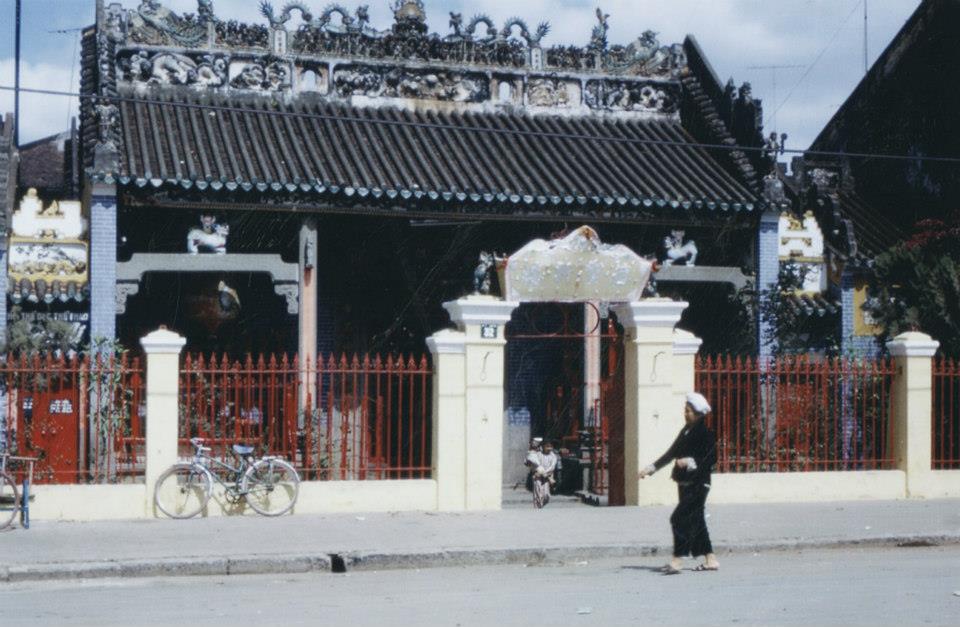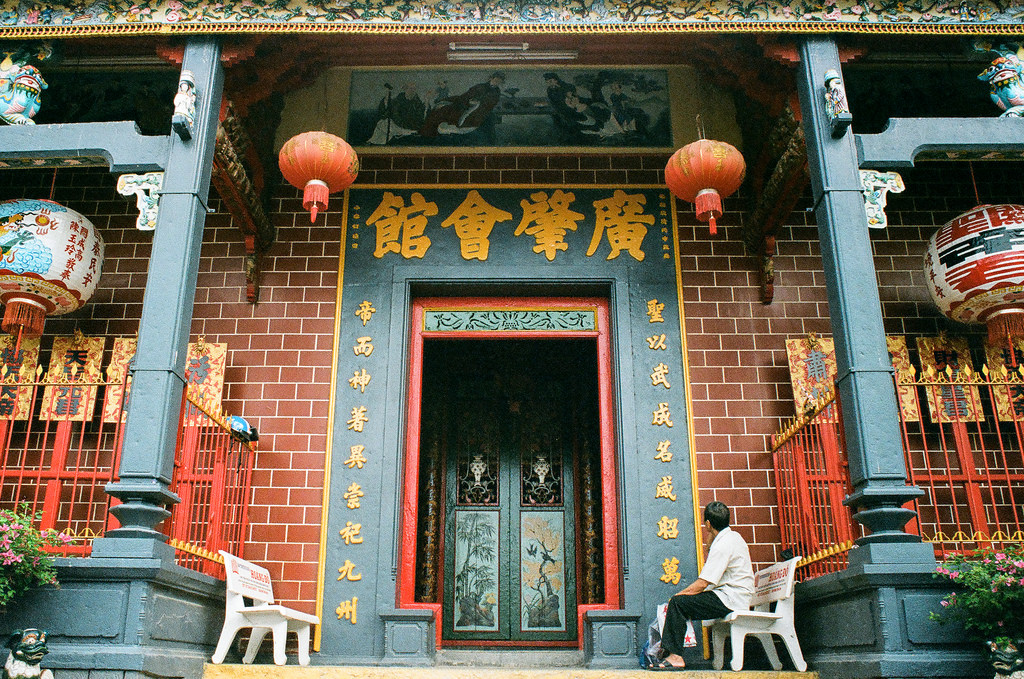Ong Pagoda is one of the ancient temples in Can Tho showing the unique culture of the Chinese people. With delicate architectural lines, patterns imbued with unique Chinese culture. The beauty of the temple is still lasting over time, worthy of being a beautiful temple in the Southwest region, becoming a famous destination of Can Tho. When traveling Can Tho to Ong Pagoda, you can feel the space is sacred and sincerely pray for peace and happiness for your loved ones.
Ong Can Tho Pagoda – The typical temple of the Southern Chinese people
Ong Pagoda is located at 32 Hai Ba Trung Street, in Tan An Ward, Ninh Kieu District, Can Tho City. The original name of the temple is Quang Trieu Hoi Quan – the assembly hall of the Chinese in two palaces, Guangzhou and Trieu Khanh, in the Guangdong province of China, is a place to worship, exchange, meet fellow countrymen, help each other do business. to settle down and settle down in a new land.
Old Ong Pagoda’s photo
Ong Pagoda started construction in 1894, completed in 1896. Unlike some other Chinese pagodas, Ong Can Tho Pagoda does not have a stele used to sign the names of those who started the construction of the pagoda, the date of completion, but in the plaques are carved wood, or a pair of vases. style, on the censer are clearly written the name of the author, those who supported it and the year it was made.
The original name of the pagoda is Quang Trieu Hoi Quan – the assembly hall of the Chinese people
Talking about the name Ong Pagoda, people here are used to calling it like that because in the temple, right in the main shrine of Quan Thanh De Quan, that is, Quan Cong, a famous general of the Three Kingdoms period. Some people are used to calling it Ba Pagoda, because this place also worships Thien Hau Thanh Mau, Buddha Ba Quan The Am, two Buddhas who save suffering and rescue in the mind of the Chinese people.
Ong Can Tho Pagoda, like other temples of the Chinese ethnic group, is not isolated, but blends in with the bustling residential area. The appearance of Ong Pagoda stands out in the middle of the neighborhood, colorful decorative architectural pieces attract all eyes. The temple is the spiritual place of the majority of the Chinese, so it is imbued with Chinese culture.
The temple has an architectural layout in the shape of the letter Quoc, roofed with yin and yang tiles. The roof ledges are glazed with blue glazed glazed glazed moss mixed with moss, creating an ancient look. The roof of the pagoda with a solid truss system is supported by round wooden columns painted in red, green stone canopy, adorned with opposite pairs, and diaphragm panels. The ends of the trusses and crosses are carved with classical-style patterns and painted in gold according to the tradition of temple dance.
Ong Can Tho Pagoda represents the architecture of temples and shrines of the Chinese, with a pair of unicorns flanking the main door suggesting peace and prosperity. Besides the dragon and phoenix symbols, there is also a statue of Ong Nhat Ba Nguyet, which is an auspicious omen, symbolizing yin and yang in Asian culture.
Ong Can Tho Pagoda has very beautiful and sophisticated architecture and decorative patterns
On the roof of the pagoda decorated with two dragon paintings, the two sides are the image of a fish transforming into a dragon arranged in opposite directions. This is a fairly common decoration style at the Hoa pagodas in the South in the late 19th and early 20th centuries. Right below are populations of colorful porcelain figurines, depicting the scene of the fairy world mixed with the mundane, and the shaping techniques are also half-real and half-false. According to the elders, these decorations were brought from Guangdong, clearly showing the art of handmade ceramics of Chinese artisans of the Qing Dynasty.
The outstanding feature of Ong Pagoda is the art of embossed sculpture on reliefs present everywhere, from the bao lam, the diaphragm, the lily with extremely rich content, drawn from the myths and history of China. Quoc: Tam Quoc Chi, Ngu Ho Binh Tay, Bat Tien, Dong Chu Lieu Quoc, Aquarium or embodied in the technique of submerging the conventional themes of apricots, orchids, chrysanthemums, bamboos, dragons adoring the moon, fish in the form of fairs , phoenix…
In addition to the art of wood carving, the artists also show their talent in calligraphy: the typefaces “seal” and “tao” are carved on the diaphragm, lily, urn, and bronze bells. beautiful and sophisticated. Because of its values, Ong Pagoda has been recognized as a national architectural and artistic relic since 1993.
Ong Pagoda has been recognized as a national architectural and artistic relic
Flower pagodas usually do not have gardens around like Vietnamese and Khmer pagodas. Instead, there is a landscaped yard surrounded by brick walls, decorated with symmetrical terracotta reliefs on both sides. From the courtyard to the main hall, there is a row of three grinding stone incense tables, where pilgrims prepare offerings and light incense before entering to worship. In the temple, there is a bronze bell cast in 1892, which still rings when there are visitors from all over the world to visit the temple.
In order to have light and create ventilation, Ong Pagoda is arranged with a space on the roof, called Thien Tinh, or “sky well”. This is also the place to release smoke for hundreds of incense sticks to radiate day and night.
The “sky well” creates light and ventilation for the temple.
Another impressive feature of the temple grounds is that there are dozens of large red cone-shaped incense sticks hanging from the top of the head.
Visitors are impressed by dozens of large red cone-shaped incense sticks hanging in the air
From the Assembly Hall of compatriots Quang Trieu, Ong Pagoda gradually became a place to show solidarity and mutual support between the Chinese people, and between the Chinese and the ethnic brothers living on the banks of Hau Giang.
Ong Pagoda also follows some beliefs and holidays of Vietnamese culture, but the pagoda has its own holidays such as: Ong Bon’s death anniversary on the 15th day of the third lunar month – The person who has contributed to building the overseas Chinese community; the day of the Quan Thanh De – Quan Cong on the 24th day of the 6th lunar month; Thien Hau’s day on the 23rd of the third lunar month.
In particular, his temple also has a lantern contest held every 10 years with the concept that whoever owns a lantern will have luck and success. If traveling to the West of Can Tho to Ong Can Tho temple on the right occasion of the festival, visitors will feel the bustling atmosphere, crowded with people going in and out of the temple to light incense, worship and respectfully offer incense.
Sacred space, fragrant incense smoke at Ong Pagoda
Choosing to visit Can Tho by booking a Can Tho tour or self-sufficient must have a destination in Ong Pagoda. Because when visiting the temple, you also have the opportunity to learn more about the religious culture of the Chinese people, as well as see the solidarity of the Chinese community working far away from home. The spiritual and cultural values of the temple have made a unique feature unlike any other religious works in Vietnam.
Ong Pagoda also has great significance in enriching Vietnamese religious culture, creating an environment of interference with indigenous religions and beliefs. Hopefully, through the article about Ong Can Tho pagoda, you have gained more interesting information about this place.
Source: Collected internet.







